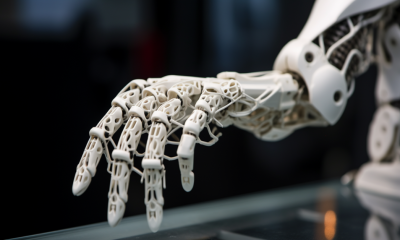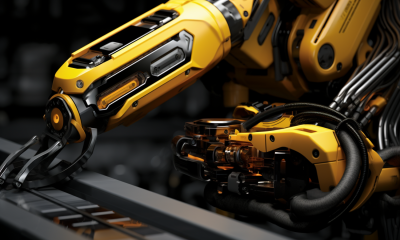Robotics
Magnetic Gel Capsules Could Advance Both Robotics and Medicine
Securities.io maintains rigorous editorial standards and may receive compensation from reviewed links. We are not a registered investment adviser and this is not investment advice. Please view our affiliate disclosure.

Magnetic Polymers
Prof. Abdon Pena-Francesch, head of the BioInspired Materials Lab at the University of Michigan, and his team have developed a gel with magnetic properties – despite it being composed exclusively of carbon-based molecules. This magnetic gel, called ‘TEMPO magnets', allows it to be attracted to other magnetic materials and respond to magnetic fields. This can allow for remote manipulation of the gel. For example, a capsule in the stomach could be directed to perform surgery or deliver medicine.

Source: University of Michigan
The magnetic properties of this TEMPO-based gel are weaker than metal-based magnets, but this can be a strength for biomedical applications and certain soft robotics. For example, MRI could be used in combination with this technology, where a stronger magnetic would make the MRI essentially blind. So, in this case, MRI can be used to monitor the effects of a medical capsule, if a drug got delivered properly and where, or the movements of a magnetic gel capsule in the digestive tract.
The Next Steps
The next step of this specific project will be to make this type of gel biodegradable, allowing more tolerance by the human body, as well as the possibility of using it in nature without worrying about contamination and pollution.
Besides magnetic gels, 3D printing/additive manufacturing should also be a boost for soft robotics. Slow-curing, elastic-plastic provides good options for prosthetics that go beyond the existing options. We discuss this growing connection between the emerging fields of soft robotics and 3D printing in our article “Hands Like a Human: New Additive Manufacturing Helps Soft Robotics Go Real”.
We also looked at the 3D printing industry at large in the article “Top 10 Additive Manufacturing And 3D Printing Stock to Watch”.
Moving Away From Hard Robotics
As it stands, robots have discreetly become an important part of our lives. But this has mostly been limited to the heavy, industrial robotic arm design. More recently, drones and smaller delivery or logistical robots are starting to take over even more tasks and even grow in importance in warfare. However, these designs are still reliant on hydraulics and heavy, metal-based systems.

Source: Unsplash
Too rigid materials limit the applications for robots, with, for example, limited movement range or difficulties in handling delicate objects. The mechanical and metallic nature of robotics has also been a major limitation in its implementation in medicine, like prostheses or internal nanorobots.
Soft Robots
There has been a strong effort to develop a so-called “soft robot”, using plastics, polymers, metal wires, or other more flexible components. Softer designs should allow for new concepts, more inspired by nature, to be used when building a robot, as we discussed in our article “How Robotics Can Take a Cue From Nature”.
But these systems still suffer from a few limitations:
- They need to be tethered to a power source.
- They are often limited to a few predetermined shapes or movements.
- They are rather heavy.

Source: Youtube
An idea to remove these limitations is to use magnets instead of rigid metal parts. This removes the need for an external power source and offers more flexibility and diversity of possible shapes and movements.
But metallic magnets are still heavy. They are also, most of the time, toxic to some extent, making their usefulness in medical applications very limited. And that's a shame, considering robot interaction with soft & fragile tissues for medical needs is one of the most promising applications of soft robotics.
However, no physics rules say that magnets necessarily need to be made of metal. Magnetic properties are the only requirement. And other materials can fit the bill – just like TEMPO magnets.
Soft Or Magnetic Robotic Stocks
1. Stereotaxis
Stereotaxis, Inc. (STXS +1.85%)
Stereotaxis is a leader in medical telerobotics. Its Genesis RMN (Robotic Magnetic Navigation) system uses magnetic fields to guide catheters in a patient's body. This is notably used in cardiac surgery and other endovascular treatments.
It is the only available robot in this sector, which differs from laparoscopic surgery, dominated by Intuitive Surgical (ISRG) and open surgery robots by the likes of Stryker (SYK – Mako robot) and Medtronic (MDT – Mazor robotics). We discussed these 2 companies and others in our article “Top 5 Robotic Surgery Stocks”.
This method removes the need for rigid catheters that rely on manual control and operator force, leading to higher risks of adverse events for the patients.
In addition, the traditional method for catheter implementation requires X-rays, which cause radiation exposure, especially for the medical personnel doing the procedure regularly. It is a well-known phenomenon that this can cause cancer for the doctors and nurses practicing these operations.

Source: Stereoaxis
The manual procedure also requires a lot of skills, which requires costly training, and will see variable success rates depending on the operator and his experience.
By contrast to the classical methods, Stereotaxis' solution provides 72% fewer complications and 36% less radiation exposure.
The company has already deployed its system to 100+ hospitals and treated 100,000+ patients.
As Stereotaxis already uses remote magnetic navigation for surgeries, it would make sense that the company will be in a prime position to embrace the emergence of organic magnetic robotics. And see its RMN robots being the basis for deployment in hospitals of the magnetic organic gel technology.
2. 3D Systems Corporation
3D Systems Corporation (DDD +4.24%)
This leader of the 3D printing industry has also moved into bioprinting in 2017 with a research collaboration with United Therapeutics (UTHR). It also acquired bio-ink maker Allevia in 2021. And it announced a collaboration with CollPlant Biotechnologies (CLGN) in 2020.
This acquisition gives 3D Systems a lead ahead in the field of printing biological materials. It currently commercializes 3 models of its Allevi bioprinter.

Source: 3D Systems
As a growing producer of 3D-printed medical devices and prostheses AND a leader in bioprinting, we can imagine the company could be interested in finding new applications for remotely controlled organic magnetic gel.
So, if soft robotics using magnetic gel becomes a growing medical application, we can expect 3D Systems to be part of this medical revolution and help 3D print the relevant tools for these new therapies.
(We explored the field of bioprinting in depth in our article “Organs On Demand: Best 3D Bioprinting Stocks”).
3. Desktop Metal, Inc.
Desktop Metal, Inc. (DM +1.02%)
Desktop Metal, Inc. (DM +1.02%)
Desktop Metal is another large 3D printing leader, with 650+ patents, 250+ possible materials, and 6,000 customers. One of its key centers of focus has been metal 3D printing, a target long sought after by the 3D printing industry.
It is also active in healthcare, starting from acquiring German EnvisionTEC, which includes dental care technology. This comes in tandem with a strategic partnership with the leading orthodontic firm Align Technology.
The merger with EnvisionTEC also helped Desktop Metal to develop its Desktop Health 3D printer. It is more of a scaffold printer than a full-cell/organ 3D printer. Still, if bioprinting turns out to require hydrogel or other polymers as a scaffold permanently, this will be a strong technological advantage for Desktop Health.

Source: Desktop Metal
While the focus on bioprinting and healthcare is less strong than with 3D systems, it is not impossible that Desktop Metal might also be interested in the potential of mixing 3D printing and organic magnetic gels.
4. Soft Robotics
This company is privately listed and focused on developing mGripAI, a robot with a soft grip for the food processing industry, combined with a full 3D vision and AI system.

Source: Soft Robotics
You can also see it in action in this video. While not likely to enter the medical segment, the company could maybe one day be interested in a non-toxic version of magnetic soft robotics for deployment in the food industry. This is especially true if the organic magnetic gel can be improved to become biodegradable.












